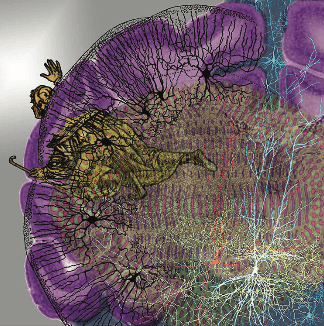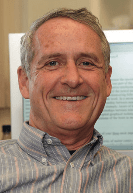
On the Machinery of the Mind
April 1, 2021
 by Eberhard Konin Fetz
by Eberhard Konin Fetz
As a neuroscientist, I take the view that the neural networks in our brain form the machinery of the mind. In other words, our conscious and unconscious mental activity is mediated by the dynamic interactions between populations of neurons. The mind-brain relation is certainly a complex and still mysterious phenomenon, but there is good evidence that neural activity is the necessary precursor for mental events. As a Zen practitioner, I appreciate the alternate view: that consciousness is the primary reality, manifesting throughout the world, and that the brain is simply a receiver of this more fundamental awareness rather than its generator. OK, fine. This is ultimately a distinction without a difference. For one thing, the brain needs to interact with the world to create mental events.
Rather than argue that point, let’s consider the practical question: whether our knowledge of how the brain works can elucidate our spiritual practice. In particular, consider two examples: the neural basis of conscious experience and learning.
Many functions and quirks of the brain can be seen to have evolved for their survival value. The ability to perceive sensory inputs has obvious benefits for survival, so those ancestors whose brains had the circuitry to better represent the world lived longer to pass on their genes. And this capacity evolved to include mental representation of agency, in both others and ourselves.
Many functions and quirks of the brain can be seen to have evolved for their survival value.
Recordings of neural activity in awake subjects have revealed remarkably close correlates with the contents of conscious experience, including sensory perception, volition to move, thinking and emotions. Moreover, stimulating those neural systems can generate associated mental events. And lesioning brain areas destroys the capability for the associated functions. So this all points to the primacy of neural mechanisms as the underlying machinery of the mind. My rule of thumb is that anything we can be aware of emerges from some associated neural activity. This includes mechanisms of attention, meditative states, awakening experiences, etc. (And more immediately: whatever is going on in your mind right now is all done with neurons.)
As any meditator who has tried to maintain attention on the breath knows, the mind relentlessly comes up with other things to attend. This “monkey-mind” tendency for attention to jump from one thing to another probably also evolved because it has survival value: in the past, an ancestor focusing on their meal and ignoring the rustling brush behind might have ended their incarnation. For today’s sitter trying to maintain focus on the breath, the same neural mechanisms continuously create distracting diversions.
These issues concern neural correlates of the contents of consciousness. What about consciousness itself? I like the current view that the brain has many systems processing information simultaneously, and while the contents of one of these reaches conscious awareness, most continue their activity in the subconscious background. And practice can help train the mind to strengthen sustained concentration.
Which brings us to learning. A basic principle of neuroscience concerns the mechanisms underlying learning. We know that neural activity creates changes in neural connections, producing conditioning. “Neurons that fire together wire together.” This explains memory and the tenacious grip of our egoic self in our mental existence. We have become ego-holics because the concept of self has been continually reinforced from birth. We are always at the center of incoming sensory events and the perceived source of behavior, as well as having our personal identity strengthened through social confirmation. The current narrative of myself with past and future is continually reinforced as the brain ruminates and strengthens these mental/neural representations. Real as it seems, the egoic self is ultimately one of our conditioned mental constructs. And since the ego has been conditioned through experience, it can also be deconstructed and unconditioned. I thought for a while that the way to liberation from the conditioned self was to identify with the conscious witness, not with any contents of consciousness. The witnessing awareness is pure, able to see what the mind produces, but separate and free. But as the Buddha observed, even consciousness itself is one of the aggregates, like sensory perception, thoughts and emotions. Indeed, identification with the witness requires the mental machinery of self-identification.
“Neurons that fire together wire together.”
Reprogramming the brain to escape conditioned patterns involves well-known mechanisms of neural plasticity. Particularly important is repetition. For example, thanks again to evolutionary pressures to survive, the brain tends to remember negative experiences and to neglect the posiitive. Like “Velcro for the bad and Teflon for the good,” as Rick Hanson puts it. However, by deliberately applying neural rules for conditioning, namely extending the awareness of positive experiences, one can train the brain to experience more of the upside and to “hardwire happiness.” The same goes for dealing with other conditioned delusions like ego: repeated mindfulness practice leads to separation and eventual liberation.
Given the symbiotic interaction between mind and brain, it is not surprising that spiritual practice is consistent with basic principles of neuroscience. Which means that there are many ways that our understanding of neural mechanisms can elucidate those of the mind and facilitate effective practice.
Dr. Fetz (Konin) is a member of ZCLA and a Professor in the Departments of Physiology & Biophysics and DXARTS at the University of Washington, Seattle WA.
